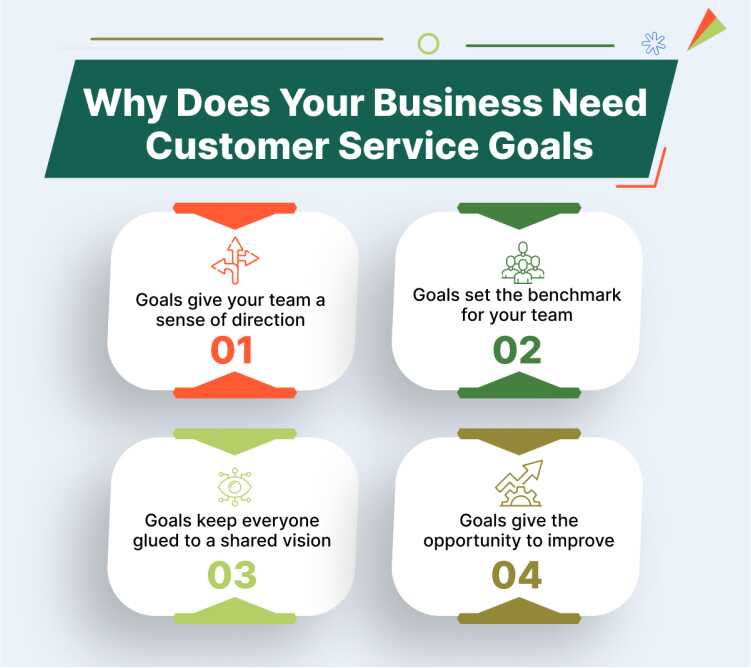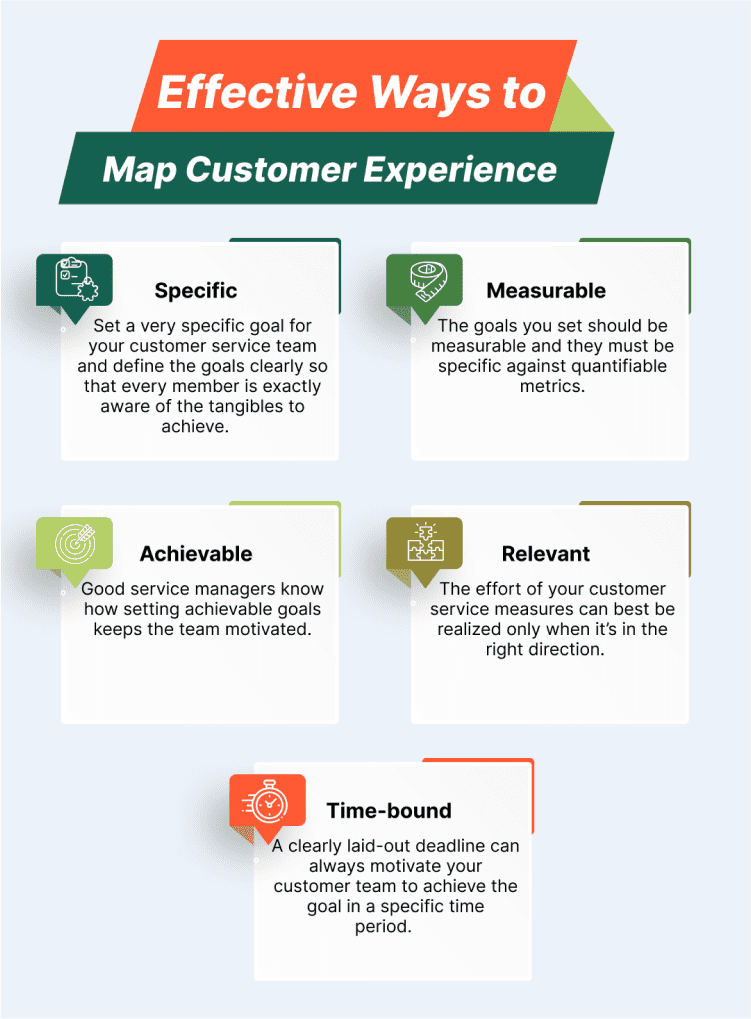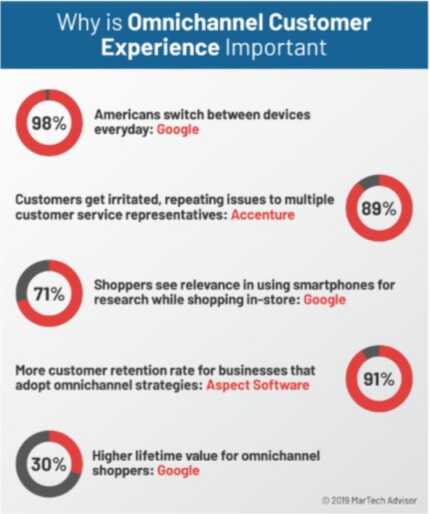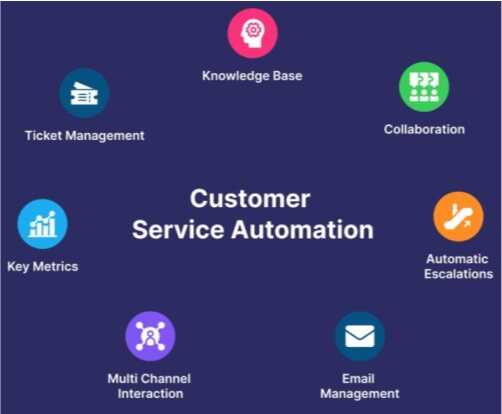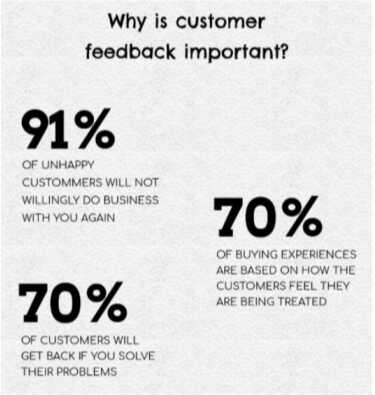SMART Customer Service Goals – How to Set and Achieve them?
- February 10, 2023
- 13 mins read
- Listen

Table of Content
If you run a business, you are aware of the fact that creating happy customers is never an accident. You also understand that happy customers won’t happen unless a business is investing time and effort in improving the customer service processes. All this shows that companies that work on their service experiences are more likely to deliver great customer service, and therefore more likely to have satisfied customers as well.
However, that kind of customer service can never be delivered unless there is a clear road map and plan of action in place. Maybe that’s why teams that follow customer service goals always find it easy to achieve customer satisfaction than those that have no direction to follow.
With no clear goals, a team can fail to know its roles, what is expected of it, and how far to go to serve customers, resulting in poor service standards. On the other hand, when there are effective goals, customer service teams understand what to do and how to go about their business, resulting in improved overall performance.
So, we can see how it’s easy to ensure consistently good service and meet customer expectations if you have goals in mind. In this blog post, we will look at customer service smart goals, how to set them, and how to achieve them.
Why Does Your Business Need Customer Service Goals?
Setting clear-cut customer service development goals is quite like giving your team a map to navigate the journey. And with a map in hand, you’re always sure your team can’t divert from the path it’s meant to go. Plus, 9 out of ten customers are likely to make a repeat purchase after a positive customer service experience.
Your business needs to set customer service goals as it can serve a variety of purposes.
- Goals give your team a sense of direction – Your customer service team can feel motivated towards a target, will be aware of the route & plan to follow, and may know the boundary of the decisions for achieving satisfied customers.
- Goals set the benchmark for your team – Agents feel more committed and driven to their tasks when they have tangible parameters to check their performance against and bring the required changes in themselves.
- Goals keep everyone glued to a shared vision – A sense of teamwork and cohesion is more visible in teams that have stated goals to follow. When every member of the team is aware that how their action is responsible for the end result, it fills a sense of energy and motivation into them.
- Goals give the opportunity to improve – Customer service feels teamwork only when all the members are working towards the same cause of ensuring great service to customers. And this unity among members often gives them a reason to improve and get better at the job.
What are Customer Service SMART Goals?
Most customer service teams have goals to follow but not all of them are able to deliver the kind of service they should. Why? Maybe the goals are not realistic or their goals lack the structure to make an impact. No such problems happen with customer service SMART goals because they are –
Specific
Set a very specific goal for your customer service team and define the goals clearly so that every member is exactly aware of the tangibles to achieve. Don’t let any vagueness deviate the team from the goals.
Measurable
The goals you set should be measurable and they must be specific against quantifiable metrics. When the goal is measurable you can always track your KPIs and measure the performance of the team at a particular point in time.
Achievable
Good service managers know how setting achievable goals keeps the team motivated. If the goals are high, chances are the team might fail to achieve that, resulting in a feeling of failure. However, attainable targets can work magic and keep the team inspired.
Relevant
The effort of your customer service measures can best be realized only when it’s in the right direction. This means, if the goal is not relevant to the cause of boosting customer experience, it can never add to the overall result you expect.
Time-bound
A clearly laid-out deadline can always motivate your customer team to achieve the goal in a specific time period. The more reasonable the deadline, the more upbeat and optimistic a team can feel.
Customer Service Goals and Objectives Examples
As you can see from the SMART goal strategy, customer service manager goals should be specific and they should be something your agents can relate to.
Some examples of customer service goals and objectives would feel like this –
- Let’s say a business does not have a presence across channels and it’s not able to deliver support on the channel of the customer’s choice. So it should aim to increase its reach by more channels in the next 2-3 months till it achieves a full-fledged omnichannel strategy.
- Let’s say a business does not have a social media team in place and is currently unable to respond to more than 20% of queries and also taking more time to respond. So, for it, the right customer service goal would be to have a social team in place at the earliest and respond to 90% of queries on time.
Key Customer Service Goals For Your Business
Good customer service can benefit your business in more ways than you imagine. It can not only boost retention but can also reduce acquisition costs. And when the service is good, it converts customers into brand loyalists. All this can only be achieved when you know what customer service goals to follow.
Here are some of the key customer service manager goals for your business to set and follow.
1. Deliver Omnichannel Support
It’s true that customers today have more options for channels than ever before. They can use any channel of choice and reach the business. So they also want support on any channel they find helpful. This means businesses have to be where the customers are if they want to provide good service.
Omnichannel support can help achieve that goal easily. In this type of support, all the customer conversations across channels are streamlined to seamlessly engage with customers over their preferred channels.
With omnichannel support, every type of conversation, be it text, email, messages, or social interactions is received at one centralized place which makes responding easy and quick. With this type of approach, your business can not only break all the silos but can also ensure consistent support across touchpoints.
How to deliver omnichannel support?
- Manage all the customer conversations under a single platform with the view to speed up responses.
- Ensure a mix of automated and human support to tackle a high volume of conversations and ensure promptness with support across channels
- Focus on connecting with customers in real-time so that the wait time is reduced considerably
2. Provide Instant Responses
Customers hate waiting. The more you make them wait for responses, the more frustrated they can feel. And when customers are frustrated, they might think of leaving you as well. As a business, losing your hard-earned customers for slow response time could be nothing less than a travesty.
So, you should always prioritize fast responses with a focus on addressing their concerns at the earliest. Make sure your customers don’t have to wait for support assistance, and also ensure that they are never put on hold for a long time.
Response time is always a huge component of increasing customer satisfaction. And if your service team is resolving customer issues quickly more often, they offer great experiences more often.
Tips to provide instant responses to customers
- Your support team can use live chat software and speed up response time to customer queries.
- The use of live chat can prove very helpful in starting a proactive conversation with customers and guiding them through their journey.
- Agents can use personalized triggers to know their customer issues or can route chats automatically to the right department for quick address
3. Add Automation to Your Customer Support Strategy
It’s true that automation is not as intuitive as your agents could be, or it may not have the kind of human touch customers vouch for, but it can still add great value to your customer support strategy. And if automation were really not that effective, most companies that are trusting it would not be using it in the first place.
And two of the biggest benefits that automation can provide include –
- Ensuring 24×7 support
- Reducing customer service costs
But yes, you need to be strategic in implementing automation in your customer service strategy. Rather than using it to replace human support completely, the best way is to use it to complement the existing support team and make it more productive.
Different ways to use chatbots for customer support
- You can add an AI chatbot to your website to offer quick answers to common queries
- It’d be equally helpful if you automate data collection tasks and free up the personnel for more important work
- Automation can also be set up for getting notifications regarding customer query updates
4. Implement Self-Service Tools for Your Customers
Not all customers vouch for support at the hands of agents. Some of them may also look to find things on their own, sometimes. Since the number of customers exploring self-service options is growing, your business too should prepare itself for these changed demands of customers.
So, you should consider implementing self-service tools and options to complement the human form of support and also to bridge the service gap. The best you can do is to include how-to-videos, product guide videos, forums, tutorials, and a comprehensive knowledge base.
When there are tons of self-service options available, more of your customers may like to help themselves and use those options to find help on key matters. And since your support team won’t be needed to handle such customers, it can always contribute to its productivity.
Role of self-service in improving customer service
- Such service is available round the clock and customers needn’t either rely on or wait for a support team for help
- Customers can quickly find out specific information without having to wait long as is the norm
5. Measure Customer Satisfaction Regularly
All your customer satisfaction effort would definitely be worth more if you regularly measure them. It can provide you valuable insights into what ticks with customers and what does not. And when you measure customer satisfaction regularly, you can always know the areas to work on further and optimize.
The metrics you measure can also indicate the features and aspects that are making customers happy and the others that are not adding the kind of value you expect. Based on the key insights at hand, you can always implement feedback across all touchpoints and improve the overall experience of customers with your brand.
Key customer satisfaction metrics to measure
- You can measure the Customer Satisfaction Score (CSAT) metric by asking customers to rate their satisfaction level with any aspect of the service and then score their responses.
- The Net Promoter Score (NPS) metric would be helpful in checking the likelihood of your customers referring your brand to others and then measuring the response on a scale from 1 to 10.
6. Empower and Help Your Customer Service Team Grow
Empowered agents are more likely to make customers happy. They stay forever motivated and often perform consistently well against key metrics.
After all, poor customer service can make 33% of customers consider switching companies and this is where empowered agents can save the day.
Plus, investing in your customer service team has the potential to benefit your business on three very important fronts –
- It can positively impact the bottom time
- Your customer retention will improve
- And your workplace will attract the best talent
Ways to empower your team and help them grow
- Train them on a regular basis and offer them the best available tools in the industry to do their job
- Customer service management should hold regular meetings with teams and offer them personalized feedback
- Give them more responsibility and freedom to express
- Create an environment where agents are ready to come up with creative ways to serve customers
7. Collect Customer Feedback More Often
Listening more to your customers is always key to offering great experiences. The more you collect their feedback, the more you can improve the standard of service, resulting in more happy customers.
When you collect feedback on a regular basis, it shows your intent to optimize customer service and improve the experience. And if customers are happy, they often give away feedback which you can implement and improve the performance of delivery.
Feedback not only improves service but also gives customers an opportunity to voice their concerns and satisfaction.
Tips to collect customer feedback
- You can use advanced tools like live chat software, and chatbots to get instant and real-time feedback after every conversation.
- You can also create personalized follow-ups or put in place an automated response workflow for getting feedback in a smooth manner.
- Understand the specific purpose of the feedback and use both open and close-ended questions and elicit the right responses.
Boost Customer Service Manager Goals with the REVE Platform
Customer service must keep pace with the changing times around and meet the requirements of customers in the way they want.
At REVE Chat, we understand how your customer service efforts can get a massive boost with AI-powered technology and tools.
In fact, you can use our AI chatbots and improve various aspects of your support. From automating the responses to offering 24×7 answers, you can achieve all with our powerful bot.
Your customer service endeavors can also leverage our top-class visual engagement tools such as video chat software and co-browsing feature to ensure real-time and relevant support to customers.
Plus, our live chat software is advanced and comes with a whole host of features helpful for customer engagement.
Conclusion
Customer expectations continue to evolve and grow and your teams too should align with that. The right strategy is to have specific goals so that the team is aware of its responsibility.
More so, there are some great engagement tools that your service team can use and make it job a lot easier. With these tools, achieving short as well as long-term goals for customer service becomes easier.
You can start free trial of top customer engagement tools and see how they can add value to your overall support effort.

